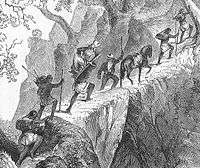Tumpline


A tumpline (/tump-lyne/) is a strap attached at both ends to a sack, backpack, or other luggage and used to carry the object by placing the strap over the top of the head. This utilizes the spine rather than the shoulders as standard backpack straps do. Tumplines are not intended to be worn over the forehead, but rather the top of the head just back from the hairline, pulling straight down in alignment with the spine. The bearer then leans forward, allowing the back to help support the load.[1]
Tumplines are often used to transport heavy loads across uneven terrain such as footpaths and portages. The voyageurs of the North American fur trade used tumplines exclusively to carry their cargo of pelts and rations across portages.
Backpacks for the military and recreational campers were redesigned to carry larger loads during the middle and late twentieth century, and tumplines have become less common in the developed world.
The indigenous natives in Mexico (and other Latin American countries) traditionally have used the tumpline for carrying heavy loads, such as firewood, baskets (including baskets loaded with construction materials and dirt for building), bird cages, and furniture. In the 1920s there was a man in Mexico City who delivered pianos on his back using a tumpline. In Mexico a common name for tumpline is "mecapal". Modern highland Mayans of southern Mexico use tumplines for various pedestrian transport.[2] During World War Two, the Canadian Army developed special supply packs for moving supplies over rough terrain where the soldier use the tump line.[3]
See also
References
- ↑ Conover, Garrett, 1991. Beyond The Paddle - A Canoeist's Guide to Expedition Skills: Poling, Lining, Portaging and Maneuvering through Ice.
- ↑ Brill, David (2004) [1975]. In Focus, National Geographic Greatest Portraits. pp. 344–345.
"Mayan Children in the Mexican Highlands", photo of Maya girl [ca. age 10], man [ca. age 60], and boy [ca. age 13]. The girl has a bandana tumpline across the top of her head with each end tied to each side of a cloth sack; the man has a narrow woven-strap tumpline across top of head.
- ↑ "Troops Use Indian Tump Line To Pull loads." Popular Mechanics, December 1944, p. 55
- Conover, Garrett (April 1991). Beyond The Paddle: A Canoeist's Guide to Expedition Skills: Poling, Lining, Portaging and Maneuvering through Ice. ISBN 0884480666.